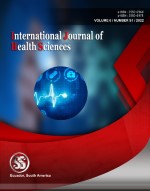Community-based intervention for the prevention of stunting in children age 6-59 months
A systematic review
Keywords:
Community-based interventions, stunting prevention/countermeasures, childrenAbstract
Stunting is still a primary nutritional problem in many parts of the world. Globally, WHO (2021) has stated that 22% of children under five years are stunted, equalling an estimated 149.2 million children, most of whom are found in Asia and Africa. Many factors cause stunting, so the government needs a multisectoral approach to overcome this problem. In addition, because stunting is prevalent across vast areas, community-based interventions can save time and handling costs. This study was conducted with the aim of finding evidence of community-based interventions in the management of stunting in children aged 6-59 months. The study employed systematic review methods using the databases Pubmed, Ebsco, ProQuest, Emerald, Scopus and Google Scholar. 7 articles were identified from a total of 1191 articles through analysis using the PICO approach. The analysis showed that community-based interventions have taken place employing education, training, dietary supplements, and monitoring growth and development. The findings show evidence of interventions overcoming the problem of stunting in children aged 6-59 months.
Downloads
References
Candarmaweni and Amy Yayuk Sri Rahayu. 2020. Stunting Prevention Challenges in the New Adaptation Era "New Normal" Through Community Empowerment in Pandeglang Regency. Indonesian Health Policy Journal: JKKI Vol. 09, No. 03.
Dattilo, A. M., & Saavedra, J. M. (2020). Nutrition education: Application of theory and strategies during the first 1000 days for healthy growth. In Nutrition Education: Strategies for Improving Nutrition and Healthy Eating in Individuals and Communities (Vol. 92, pp. 1-18). Karger Publishers.
Gelli, A. et al. l (2018) Using a Community-Based Early Childhood Development Center as a Platform to Promote Production and Consumption Diversity Increases Children's Dietary Intake and Reduces Stunting in Malawi: A Cluster-Randomized Trial. The Journal of Nutrition: Nutritional Epidemiology: 148: 1587-1597. http://doi.org/10.1093/jn/nxy148
Haryani, S., Astuti, A. P., & Sari, K. (2021). Stunting Prevention through Community Empowerment with Information communication and education in Candirejo village area of West Ungaran District of Semarang Regency. Journal of Health Service, 4(1), 30-39.
Juarez, M. et al. l (2021) Community-Based Interventions to Reduce Child Stunting in Rural Guatemala: A Quality Improvement Model. Int. J. Environ. Rs. Public Health. 18:773. http://doi.org/10.3390/ijerph18020773
Kang, Y. et al. l (2017) Effectiveness of a community-based nutrition program to improve child growth in rural Ethiopia: a cluster randomized trial. Maternal & Child Nutrition. 13.c12349. http://doi.org/10.1111/mcn.12349
Ministry of Health (2018). Stunting Bulletin. Data and Information Center. Ministry of Health. ISSN 2088-270X.
Ministry of Health (2020). Stunting Bulletin. Data and Information Center. Ministry of Health. ISSN 2088-270X.
Ministry of Health (2021). Technical instructions for preparing and implementing communication strategies for behaviour change in accelerating stunting prevention. Directorate of Health Promotion and Community Empowerment. ISBN 978-623-301-184-6
Liang, W. et al. l (2018) Community health education improves child health care in Rural Western China. BMC Pediatrics 18:132/ http://doi.org/10.1186/s12887-018-1084-0
Marion L. Roche, et al. l (2017) A Community-Based Positive Deviance/Hearth Infant and Young Child Nutrition Intervention in Ecuador improved diet and reduced underweight. Journal of Nutrition Education and Behavior. Vol 49, Number 3
Ponum, M., Khan, S., Hasan, O., Mahmood, M. T., Abbas, A., Iftikhar, M., & Arshad, R. (2020). Stunting diagnostics and awareness: impact assessment study of sociodemographic factors of stunting among school-going children of Pakistan. BMC paediatrics, 20(1), 1-9.
Rahayu, A. et.al (2018) Study guide - stunting and prevention efforts. CV Mine. Yogyakarta ISBN 978-602-52833-1-4
Tyler Vaivada, Nadia Akseer, Selai Akseer, Ahalya Somaskandan, Marianne Stefopulos, Zulfiqar A Bhutta, (2020) Stunting in childhood: an overview of the global burden, trends, determinants, and drivers of decline, The American Journal of Clinical Nutrition, Volume 112, Issue Supplement_2, September 2020, Pages 777S–791S, https://doi.org/10.1093/ajcn/nqaa159
Unicef, WHO & World Bank (2021). Levels and trends in child malnutrition. Available from: https://apps.who.int/iris/handle/10665/341135
Wang J. et al. l (2017) Effectiveness of community-based complementary food supplement (Yingyangbao) distribution in children aged 6-23 months in poor areas in China. Plus.ONE 12(3): e0174302. https://doi.org/10.1371/journal.pone.0174302
White S, Schmidt W, Sahanggamu D, Fatmaningrum D, van Liere M, Curtis V. Can gossip change nutrition behaviour? Results of a mass media and community-based intervention trial in East Java, Indonesia. Trop Med Int Health. 2016 Mar;21(3):348-64. DOI: 10.1111/tmi.12660. Epub 2016 Feb 3. PMID: 26701153.
WHO (2021) joined the malnutrition estimate. Available from: https://www.who.int/data/gho/data/themes/topics/joint-child-malnutrition-estimates-unicef-who-wb
Published
How to Cite
Issue
Section
Copyright (c) 2022 International journal of health sciences

This work is licensed under a Creative Commons Attribution-NonCommercial-NoDerivatives 4.0 International License.
Articles published in the International Journal of Health Sciences (IJHS) are available under Creative Commons Attribution Non-Commercial No Derivatives Licence (CC BY-NC-ND 4.0). Authors retain copyright in their work and grant IJHS right of first publication under CC BY-NC-ND 4.0. Users have the right to read, download, copy, distribute, print, search, or link to the full texts of articles in this journal, and to use them for any other lawful purpose.
Articles published in IJHS can be copied, communicated and shared in their published form for non-commercial purposes provided full attribution is given to the author and the journal. Authors are able to enter into separate, additional contractual arrangements for the non-exclusive distribution of the journal's published version of the work (e.g., post it to an institutional repository or publish it in a book), with an acknowledgment of its initial publication in this journal.
This copyright notice applies to articles published in IJHS volumes 4 onwards. Please read about the copyright notices for previous volumes under Journal History.
















